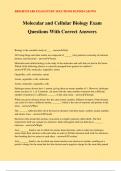BRIGHTSTARS EXAM STUDY SOLUTIONS 8/15/2024 2:05 PM
Molecular and Cellular Biology Exam
Questions With Correct Answers
Biology is the scientific study of____ - answer✔✔Life
All living things and other matter are composed of ______ (tiny particles consisting of neutrons,
protons, and electrons) - answer✔✔Atoms
Molecular and cellular biology is the study of the molecules and cells that we find in life forms.
Which of the following choices is correctly arranged from greatest to smallest? -
answer✔✔Cells, molecules, organelles, atoms
Organelles, cells, molecules, atoms
Atoms, organelles, cells, molecules
Atoms, molecules, organelles, cells
Hydrogen atoms always have 1 proton, giving them an atomic number of 1. However, hydrogen
atoms can have 0, 1, or 2 neutrons. An atom with the same number of protons but a different
number of neutrons is a different _______ of the same atom. - answer✔✔Isotope
While any given element always has the same atomic number, different isotopes of that element
can cause it to have a different atomic _______, which is the sum of neutrons and protons in the
atom. - answer✔✔Mass
The _______ table describes all of the known elements with their name, symbol, atomic number,
and atomic mass. - answer✔✔Periodic
Electrons orbit around the nucleus of an atom in complex patterns called shells. The first
(innermost) shell can contain two electrons. Each subsequent shell can hold up to _______
electrons. - answer✔✔Eight
A(n) _______ bond is one in which two atoms share electrons, such as when two hydrogen
atoms share their electrons with each other in order to fill their electron shell with two electrons,
thus bonding the two atoms to each other. - answer✔✔Covalent
A(n) _______ bond is one in which one atom transfers one electron to another, resulting in a
positive charge for the atom that lost the electron and a negative charge for the atom that gained
, BRIGHTSTARS EXAM STUDY SOLUTIONS 8/15/2024 2:05 PM
the electron. This positive and negative charge creates an electromagnetic attraction that pulls the
two atoms together. - answer✔✔Ionic
Some atoms exert more "pull" than others on the the electrons of surrounding atoms. This force
is called _______ and can attract electrons or even strip them away from other atoms, as is the
case in an ionic bond. - answer✔✔Electronegativitiy
In a covalent bond between atoms of equal electronegativities, the electrons will be shared
equally and no partial positive or negative charges will result. However, in a covalent bond
between atoms of widely different electronegativities (such as water), the partial positive and
negative charges on opposite sides of the molecule cause this to be called a(n) _______ covalent
bond. - answer✔✔Polar
The partial positive and negative charge (d+ and d-) in a molecule with polar covalent bonds can
actually create a weak electromagnetic attraction that bonds other polar molecules together. This
type of bond is called a(n) _______ bond. - answer✔✔Hydrogen
Which of the following would have NONPOLAR covalent bonds? - answer✔✔H2 and O2 are
nonpolar because each atom has an equal electronegativity, so the electron spends equal amount
of time on both sides, creating no partial positive or negative charge on one side or the other.
There are four main elements that are important for the study of biology, because they make up
approximately 96% of all living things. These important elements are: - answer✔✔Carbon,
hydrogen, nitrogen, and oxygen are called living, or organic compounds. These elements are
found everywhere--from fingernails to table sugar.
In a chemical reaction, reactants interact with each other and recombine to form _______. This
occurs when molecules collide with each other with enough force to split the covalent bonds and
reorganize. - answer✔✔Products
Chemical reactions in which molecules are broken down into smaller parts and energy is released
are called _______ reactions. - answer✔✔Decomposition
Chemical reactions in which smaller molecules are joined together to form bigger molecules are
called _______ reactions - answer✔✔Synthesis
Water is one of the most important biological compounds, essential to life. The hydrogen bonds
that constantly form between water molecules cause water to stick to itself. This property, called
_______, causes water to be more structured than other liquids. - answer✔✔Cohesion
The polarity of water molecules not only causes them to stick to each other, it also causes them
to stick to any polar sections of other molecules. This property is called _______. -
answer✔✔Adhesion




